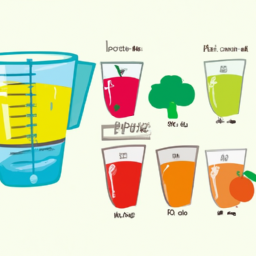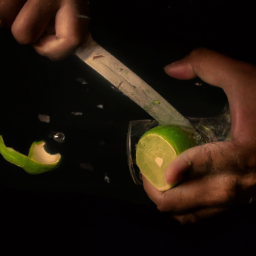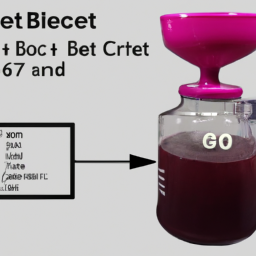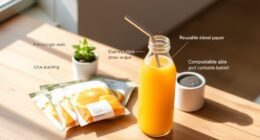Have you ever considered the costs associated with making a glass of juice? As a juice bar owner, I recognize the importance of setting the right price for our juices to ensure financial success. It’s not just about the cost of ingredients; you also need to factor in labor, overhead expenses, and profit margins.
In this article, I’ll share with you my knowledge and experience on how to calculate juice cost, so you can maximize your profits and grow your business.
Calculating juice cost is a crucial aspect of any juice bar business. Failure to do so can lead to financial losses and ultimately, the failure of your business. Knowing the cost of each glass of juice allows you to set the right price, make informed decisions on menu offerings, and adjust your recipes accordingly.
In this article, I’ll break down the process of calculating juice cost into manageable steps, so you can have a better understanding of the financial side of your business. So, let’s get started!
Key Takeaways
- Calculating juice cost is essential for running a profitable juice bar business and failure to do so can lead to financial losses and business failure.
- Factors affecting juice cost calculation include ingredients, labor, and overhead expenses.
- To optimize profit, balancing profitability with affordability is important for customer satisfaction, and cheaper ingredients, waste reduction, bulk purchasing, streamlining operations, and adjusting juice recipes can help.
- Juice pricing strategy is crucial for attracting customers, making sales, and increasing revenue, and customer preferences and overall market trends should be considered when setting prices, as well as monitoring social media activity and attending industry events for valuable insights.
Understanding the Importance of Calculating Juice Cost
Calculating juice cost is crucial for any business, as it helps determine the profitability and success of the establishment. The importance of juice pricing strategy can’t be overstated, as it’s one of the key factors that businesses need to consider in order to stay competitive.
By setting the right price for your juice products, you can attract more customers, make more sales, and ultimately increase your revenue.
There are many factors affecting juice cost calculation, such as the cost of ingredients, labor, and overhead expenses. It’s important to take these into account when calculating the cost of your juice products, as they can have a significant impact on your bottom line.
By understanding the factors that affect your juice cost, you can make informed decisions about how to price your products and ensure that you’re maximizing your profits.
Moving on to the next section, let’s take a closer look at one of the most important factors in calculating juice cost: identifying the cost of ingredients.
Identifying the Cost of Ingredients
You gotta figure out how much those ingredients are gonna set you back before you start mixing up your delicious concoction. It’s crucial to understand the cost of each ingredient you plan to use in your juice recipe.
Ingredient sourcing is essential when it comes to calculating the cost of your juice. You don’t want to end up paying more for an ingredient that you could have purchased at a lower price from a different supplier. Quality control is also essential when it comes to ingredient sourcing. You wouldn’t want to compromise on the quality of your ingredients to save a few bucks.
It’s important to factor in all the costs associated with ingredient sourcing, such as shipping charges, taxes, and any other fees. Don’t forget to include the cost of tools and equipment you will need to prepare your juice. For example, if you’re planning to use a citrus squeezer, make sure to include its cost in your calculations.
Once you have a clear understanding of the cost of each ingredient, you can move on to calculating labor costs.
Calculating Labor Costs
When it comes to running a juice bar, labor costs are a crucial aspect of the business. To determine the hourly rate for your employees, I recommend researching the market rate for similar positions in your area and factoring in the experience and skill level of your staff.
Once you have established the hourly rate, you can calculate labor hours by determining the necessary staffing levels and scheduling shifts accordingly. By carefully considering these factors, you can ensure that your labor costs are optimized for maximum efficiency and profitability.
Determining the Hourly Rate
To figure out the hourly rate for juicing, simply divide the total cost of ingredients and labor by the number of hours worked. Hourly rate optimization is crucial in the juicing business, as it directly impacts the profitability of the operation. As a cost-conscious entrepreneur, I’m always looking for labor cost reduction techniques to increase my profit margins.
Here are some factors to consider when determining the hourly rate for juicing:
-
The cost of ingredients: This should include the cost of fruits, vegetables, and any other ingredients used in the juice-making process. It’s essential to keep a record of the cost of each item to accurately calculate the total cost.
-
The labor cost: This includes the wages paid to employees who are involved in the juicing process. It’s essential to factor in all labor costs, including training, benefits, and taxes.
-
The number of hours worked: This is the total number of hours spent on the juicing process, including cleaning and preparation time.
-
The level of expertise: The hourly rate should reflect the expertise of the employees involved in the juicing process. Experienced employees should be paid more than entry-level employees.
-
The competition: It’s important to research the hourly rate of other juicing businesses in the area to ensure that the pricing is competitive.
When determining the hourly rate for juicing, it’s essential to take into account all factors that contribute to the cost of production. By optimizing the hourly rate, I can ensure that I’m maximizing my profit margins while still providing high-quality juices to my customers.
Next, I’ll discuss how to calculate labor hours accurately.
Calculating Labor Hours
As a savvy business owner, you’ll want to figure out the exact number of hours your employees are working on the juicing process to ensure that your labor expenses are kept in check.
Calculating labor hours is an essential step in determining the overall cost of your juice product. Optimizing efficiency and time management strategies can help you reduce labor hours and increase your profit margin.
To calculate labor hours, you need to keep track of the time spent on each task related to the juicing process. This includes washing and cutting fruits and vegetables, operating the juicer, and cleaning up. You can use a time-tracking tool or a simple spreadsheet to record the start and end times of each task and the employee who performed it.
Once you have this data, you can analyze it to identify any inefficiencies in your process and make adjustments to optimize your labor hours.
By considering overhead expenses, you can get a more accurate picture of the total cost of your juice product. It’s important to factor in costs such as rent, utilities, and equipment maintenance when calculating the overall cost per unit.
By doing so, you can ensure that you’re pricing your juice product in a way that covers all your expenses and provides a reasonable profit margin.
Considering Overhead Expenses
Taking into account the overhead expenses, it’s essential to factor in the cost of utilities, rent, and equipment when calculating the juice cost. Managing overhead expenses is a crucial aspect of running a profitable juice bar. To cut costs, we can consider energy-efficient appliances, negotiate rent, and purchase used equipment.
Utilities such as electricity, water, and gas are necessary for running a juice bar, but they can significantly impact the overall cost of a product. To manage utility costs, we can consider installing energy-efficient appliances and using natural light sources to reduce the need for artificial lighting.
Rent is another significant expense for a juice bar. To minimize rent costs, we can negotiate with the landlord for a lower rent or consider sharing space with another business.
Finally, equipment costs can be a substantial expense when opening a juice bar. To cut costs, we can purchase used equipment or lease equipment instead of buying it outright. By managing overhead expenses, we can ensure the profitability of our juice bar.
In the subsequent section about ‘adding up the total costs,’ we’ll take into account the labor hours and overhead expenses to calculate the juice cost accurately.
Adding Up the Total Costs
Now that we’ve factored in overhead expenses and labor hours, it’s time to add up all the costs to determine the final juice cost. One important factor to consider is the waste percentage. We need to calculate how much juice goes to waste during the preparation process.
This is crucial because it affects the final cost of each drink. If we don’t take into account the waste percentage, we may end up losing money in the long run. Once we have determined the waste percentage, we can adjust our menu prices accordingly.
We need to make sure that the prices we set cover all the costs, including the ingredients, labor hours, and overhead expenses. We also need to factor in a profit margin that will allow us to stay in business and grow in the future.
Determining the right profit margin can be tricky, but it’s essential for the success of our juice bar. With all these factors in mind, we can set our prices and start serving our customers with delicious and profitable drinks.
Determining the Profit Margin
When determining the profit margin, I always make sure to set competitive prices that align with the market trends. Researching the competition and analyzing the current market trends helps me to stay ahead of the game and make informed decisions about pricing.
It’s crucial to balance profitability with affordability for customers, and keeping a close eye on market trends allows me to do just that.
Setting Competitive Prices
To set competitive prices for your juice, you’ll want to do some market research and analyze the prices of similar products in your area. This will help you understand what your competitors are charging and enable you to tailor your prices to match or beat them. Here are some steps to take:
-
Research marketing strategies that your competitors are using. Are they offering discounts or promotions? This can help you determine whether you need to adjust your prices or offer similar deals.
-
Consider customer preferences. Are they willing to pay more for organic or locally-sourced ingredients? If so, you may be able to charge a premium for these types of juices.
-
Look at the overall market trends. Are juice prices generally going up or down? This can help you anticipate future changes and adjust your pricing accordingly.
By taking these steps, you can set prices that are competitive with other juice sellers in your area. However, it’s important to remember that pricing is just one aspect of a successful juice business.
In the next section, we’ll discuss the importance of considering market trends in addition to pricing.
Considering Market Trends
You need to keep an eye on market trends to ensure your juice business stays relevant and competitive. Like a sailor navigating rough waters, you must adjust your sails to catch the wind and stay on course towards success. Conducting a market analysis is essential to understanding customer preferences and identifying emerging trends. This information can then be used to tailor your product offerings and marketing strategies to meet the demands of your target audience.
One way to stay ahead of the curve is to monitor the social media activity of your customers. By tracking hashtags and mentions related to your juice business, you can gain valuable insights into their opinions and preferences. Additionally, attending industry conferences and participating in local events can provide opportunities to network with other industry professionals and stay up-to-date on the latest trends. By staying informed and adaptable, you can position your juice business for long-term success.
In order to maximize profit, it may be necessary to adjust the recipe of your juice products. This can involve experimenting with different ingredient combinations, varying the portion sizes, or tweaking the production process. By finding ways to reduce costs without sacrificing quality, you can increase your profit margin and maintain a competitive edge in the market.
Adjusting the Recipe to Maximize Profit
To maximize profit, I always look for ways to adjust my juice recipe without compromising quality. One strategy is to use cheaper ingredients without sacrificing taste. For example, I might switch to frozen fruit instead of fresh or opt for a less expensive brand of honey.
Another approach is to reduce labor hours by simplifying the recipe or streamlining the preparation process. This might mean eliminating a step that doesn’t significantly impact flavor or using equipment that speeds up the juicing process.
Using Cheaper Ingredients
By opting for less expensive ingredients, I can significantly reduce the cost of making juice. One way to do this is by using alternative fruits that are in season and readily available. For example, instead of using expensive imported berries for my juice, I can use locally grown apples or pears that are cheaper and just as nutritious.
Another way to reduce juice costs is by calculating ingredient waste. By measuring how much fruit and vegetables are left over after juicing, I can adjust my recipes accordingly and use just the right amount of ingredients needed. Additionally, I can use the leftover fruit and vegetable pulp in other recipes such as soups, smoothies, and baked goods, which helps to reduce waste and increase profits.
Other cost-saving options include buying wholesale and purchasing ingredients in bulk. By incorporating these cost-saving measures, I can significantly reduce my juice-making expenses. However, reducing costs isn’t just about ingredients.
In the next section, I’ll discuss how reducing labor hours can also help maximize profit.
Reducing Labor Hours
Streamlining operations and implementing automation solutions can effectively reduce labor hours and ultimately cut down on costs. As the owner of a juice bar, I’ve found that staffing schedules can be a major factor in determining profitability. By creatively cutting labor hours, I’ve been able to save on salaries without compromising the quality of my business.
One way to achieve this is by streamlining operations through the use of technology. For example, implementing a point-of-sale system can automate tasks such as taking orders and processing payments, freeing up time for staff to focus on other areas of the business. Additionally, investing in equipment such as juicers that can handle larger quantities of produce can reduce the time it takes to make a single juice, allowing for more efficient production.
By utilizing these solutions, I’ve been able to reduce labor hours and costs, ultimately increasing my profit margin.
Tracking the cost of juice over time is crucial in determining the success of a juice bar. By cutting labor hours and implementing automation solutions, I’ve been able to reduce my expenses and increase profitability. However, it’s important to continue to track these costs to ensure that my business remains financially stable and successful in the long run.
Tracking the Cost of Juice Over Time
As I’m monitoring the price of juice over time, I’m gaining valuable insights into the cost trends and fluctuations. This allows me to adjust my juice pricing strategies to maximize profitability.
Analyzing sales data and keeping track of the cost of ingredients used in each juice recipe helps me determine the actual cost of each juice sold.
By tracking the cost of juice over time, I can identify which recipes are most profitable and which are not. This allows me to make informed decisions about which juices to feature on my menu and which ones to remove.
Ultimately, this helps me to maximize profits by ensuring that I am selling the most profitable juices and adjusting prices accordingly. With this knowledge, I can move on to the next section about tips for maximizing profit.
Tips for Maximizing Profit
To maximize your profits, you should focus on finding ways to increase sales and decrease expenses. One of the most powerful ways to do this is through strategic marketing strategies. By identifying your target audience and crafting messages that resonate with them, you can increase the likelihood of sales. Consider creating promotional offers, such as discounts for first-time customers or loyalty rewards for frequent buyers. Paying attention to customer feedback can also help you refine your marketing strategies and increase customer retention.
Another way to maximize profits is by decreasing expenses. This can be achieved by conducting a cost analysis of your juice-making process. Look for areas where you can reduce costs, such as purchasing ingredients in bulk or using energy-efficient equipment. Consider implementing a waste reduction program to minimize product loss.
Additionally, regularly reviewing and adjusting your pricing strategy can help ensure that you’re charging a fair price that allows for a healthy profit margin. By implementing these strategies, you can increase profitability and position your business for long-term success.
Frequently Asked Questions
How do you determine the market demand for the juice you want to sell?
To determine market demand for my juice, I conduct a competitive analysis to understand my competition and what sets my product apart. I also research target audience demographics to ensure my product appeals to the right consumer base.
What factors should you consider when pricing your juice?
When pricing my juice, I consider packaging options and production volume. These impact the cost of materials, labor, and overhead. Analyzing these factors helps me set a competitive price that covers my expenses while appealing to customers.
How do you effectively advertise and market your juice to potential customers?
To effectively market my juice, I would focus on influencer partnerships and a strong social media strategy. By collaborating with popular influencers and creating eye-catching content, I can increase brand awareness and drive sales without breaking the bank.
What are some common mistakes to avoid when calculating juice cost?
I’m an expert at juice pricing strategies. When it comes to avoiding miscalculations, the key is to not pay attention to ingredient costs or production expenses. Just charge whatever feels right and hope for the best. Kidding! Careful calculation is crucial.
How do you handle unexpected costs or changes in ingredient prices?
When unexpected costs arise or ingredient prices change, I adjust my budget by renegotiating with suppliers and exploring alternative sourcing options. I remain detail-oriented and cost-conscious to ensure profitability while maintaining product quality.
Conclusion
In conclusion, calculating the cost of juice may seem like a tedious task, but it’s crucial for any business to ensure profitability.
As a juice shop owner, I’ve learned that identifying the cost of ingredients, calculating labor costs, and considering overhead expenses are all important factors in determining the total cost of juice.
It’s also essential to determine the profit margin and adjust the recipe to maximize profit.
As a cost-conscious entrepreneur, I’ve found that tracking the cost of juice over time and regularly reviewing and adjusting prices is necessary to remain competitive in the market.
By doing so, I’ve been able to maximize profit and provide my customers with high-quality, affordable juice.
Remember, every penny counts in the juice business, and taking the time to calculate costs can make all the difference in the success of your business.
Ilana has been a vegan for over 10 years. She originally made the switch for health reasons, but soon found herself becoming more and more passionate about the ethical and environmental implications of a vegan lifestyle. Ilana is the author of The Graceful Kitchen, a blog all about veganism. She loves to cook up delicious and nutritious vegan meals, and share her recipes with others who are interested in leading a cruelty-free life. Ilana is also a strong advocate for using whole foods as the foundation of a healthy diet, and believes that going vegan is one of the best ways to achieve this.









